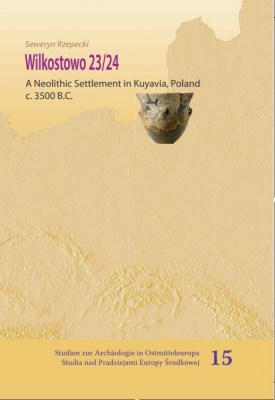 Wilkostowo 23/24 A Neolithic Settlement in Kuyavia Poland c 3500 BC
Wilkostowo 23/24 A Neolithic Settlement in Kuyavia Poland c 3500 BC
Wilkostowo 23/24. A Neolithic Settlement in Kuyavia, Poland c. 3500 BC
Informacje bibliograficzne
Tytuł: Wilkostowo 23/24. A Neolithic Settlement in Kuyavia, Poland c. 3500 BC
Autor: Seweryn Rzepecki
Wydawca: Instytut Archeologii i Etnologii PAN
Miejsce wydania: Kraków-Bonn
Rok wydania: 2015
Język: angielski
Liczba stron: 488
Format: A4+ CD
Okładka: twarda
ISBN: 9788363760533
Opis
The book consists of 20 chapters provided with numerous figures, plates, photographs, tables and maps. The volume is accompanied by a CD, which contains a collection of archaeological sources in the form of plates and tables presenting the quantitative and qualitative characteristics. Based on the results of the analyses, Seweryn Rzepecki was able to trace the origin and decline of the settlement, he characterizes the spatial organization of the site and its buildings and is referring to the form and constructional aspects of the houses. The author also defines the basic means of sustenance to the settlement. The issues of agriculture, animal husbandry, fishing, hunting and gathering are raised and the selected crafts (pottery, flint and stone work, leather craft, weaving, salt production) are highlighted. The matter of intergroup relations and the rules connected with the use of the settlement area is discussed and the social organization of its inhabitants is outlined.
Spis treści
CONTENTS:
Preface from series' editors
Preface
Introduction
1.1. History of research
1.2.Research methods
1.3.Text division
2.Surface geology and geomorphology of the site area and its surroundings
( Jacek Forysiak, Juliusz Twardy)
2.1. Aim and subject matter of the research work
2.2.Research methodology
2.3.Topography
2.4.Geological structure
2.5. Transformation of relief of the researched area
mder natural and anthropogenic conditions
3.Finds recording
- Taphonomy and stratigraphy of the site
4.1. The potential of post-depositional transformations
4.1.1. The economic exploitation of the site area from the Corded Ware culture
to the Modern Era
4.1.2.Natural sources of disturbance
4.1.3. Conclusions
4.2.The basic characteristics of the spatial patterns of the material
within the humus and cultural layer
4.2.1. Humus layer
4.2.2.Cultural layer
4.2.2.1. The TRB pottery
4.2.2.2.Pottery of the Globular Amphora culture
4.2.2.3.Daub
4.2.3.Evaluation of the rate of decomposition of the cultural layer
4.3.Description of stratigraphic units
4.3.1.Features
4.3.1.1 Post-holes
4.3.1.2. Pits
4.3.1.3.Daub debris
4.3.1.4. Identification of rubbish heaps
4.3.2. Structures
4.3.3. Preservation of the features - evaluation
4.3.4.Cultural context of features
- Pottery of the TRB culture
5.1.Taphonomy and fabric
5.2. Decoration of vessels
5.3. Morphology
5.4. Relative chronology
5.4.1. A comparative analysis of the assemblages
5.4.2. Conclusions
- Small clay artefacts
6.1. Spindle whorls
6.2. Spoons
6.3. Miscellaneous
- Pottery of the Globular Amphora culture
- The radiocarbon dates
8.1. Calibration of dates
8.1.1. Development of models
8.1.2. Chronology models for the TRB and GAC
- Pottery from the youngest period of the site's use
- Daub as a building material
- Flint materials (Lucyna Domańska)
11.1. Dispersion of the materials
11.2.Culturalcharacteristicsandchronologyoftheinventory
11.2.1. Palaeolithic and Mesolithic materials
11.2.2. Flint products related to the TRB culture
11.2.3. Globular Amphora culture materials
11.3. Conclusions
- Results of microwear analysis of flint artefacts
(Małgorzata Winiarska-Kabacińska)
12.1. Method
12.2. Materials
12.3. Conclusions
- Stone tools (Marcin Szydłowski, Seweryn Rzepecki)
13.1. The structure of tools
13.2. The raw material
13.3. Distribution of stone artefacts
13.4. Conclusions
- Amber
- Animal bones (Kamilla Waszczuk)
15.1. Introduction
15.2. Methods
15.3. Results
15.4. Conclusion overview
15.4.1. Animal husbandry in Wilkostowo 23/24
15.4.2. Taphonomic observations
15.5. Conclusions
- Bone and tooth tools (Kamilla Waszczuk)
16.1. Introduction
16.2. Methods
16.3. Results
16.3.1. Tools intended for organic materials
16.3.2. Tools used in pottery production
16.3.3. Tools of an undefined form or function
- Plant impressions on pottery (Joanna Abramów)
17.1. Analysis of impressions on potsherds
17.2.Analysis of the species
17.2.1.Hordeum sp. -Barley
17.2.2. Triticum dicoccon - Emmer wheat
17.2.3. Triticum monococcum - Einkorn wheat
17.2.4.Triticum spelta - Spelt wheat
18.Results off the mineralogical and technological study on pottery and daub
(Maciej Pawlikowski) 18.1.Rcearch methods
18.2. Results of the analyses
18.3.Condusions
- The record of prehistoric anthropogenic processes discovered
in the catchment area of the mid section of the River Tążyna
based on the geochemical analyses of the biogenic sediments
from Wilkostowo (Daniel Okupny, Anna Fortuniak, Julita Tomkowiak)
19.1. Introduction
19.2. Aim and methodology of the research
19.3.Geodemical characterization of the recorded sediments 19.4.Human activity in the catchment area of the mid section
of the River Tążyna against the phases of development
of the reservoir in Wilkostowo.
19.5. Conclusion
- Wilkostowo 23/24. From birth to death of the settlement
20.1.The initial phase of settlement
20.1.1. The site layout and erection of houses
20.1.1.1.The arrangement of buildings
20.1.1.2. Construction of the houses
20.1.1.3. Shape of the buildings
20.2. The heyday of the settlement
20.2.1.Agricultue
20.2.1.1. Cultivation of fields
20.2.1.2. Animal husbandry
20.2.2. Gathering, fishing and hunting
20.2.3.Pottery
20.2.3.1. Use of vessels
20.2.4. Flint and stone processing
20.2.5.Furriery and weaving
20.2.6.Salt working (?)
20.2.7. Existence within a system of intergroup relations
20.2.7.1. The traces of presence left by the population
of the Globular Amphora culture
20.2.8 Spatial exploitation and social organization of the site
20.3. Leaving the site area
Bibliography
Authors

